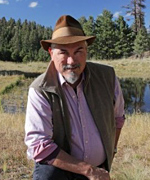 —Alan Dulaney
—Alan Dulaney
One of the most important pieces of the puzzle needed to get Pinal County agriculture to support the Drought Contingency Plan was mitigation of the impact of the sudden loss of Central Arizona Project water in a declared shortage. Key to the mitigation was the promise of infrastructure for Pinal County irrigation districts — mostly new wells. The goal accepted by all in order to get agricultural votes in the Legislature was 70,000 acre-feet from new wells by 2023. Combined with other transfers of water from Maricopa and Pima Counties to Pinal, farmers would be able to keep on farming with non-CAP water, although some acreage would be fallowed.
Lawyers and politicians tend to think that once a deal is inked and the votes cast, the game is over. Done is done. Throughout the negotiations on the DCP implementation framework for Arizona, and the mitigation of impacts on Pinal County irrigation, at no time did anyone question if drilling enough wells to produce 70,000 acre-feet within 3 years was practical. No one asked the drillers, the consultants, or anyone familiar with bringing a working well online to serve specific purposes. I see some issues.
The Money
CAP has pledged $5M towards mitigation costs for Pinal County, to be funneled through the “Central Arizona Regional Irrigation Efficiency and Conservation Project,” or CARIECP. Even the nimblest water buffalo will stumble over that acronym. Irrigation districts are contributing $5M of their own money. Arizona Water Company has committed to $1M. Groundwater withdrawal fees ($8M) from the Pinal AMA will be directed to the cause. ADWR has $9M available, and the Legislature may allocate $20M in the as-yet unfinished state budget.
CAP will retain control over its money, but the rest will go into an Arizona system conservation fund established in the DCP legislation (SB 1227). Apparently, funds will then be split amongst the various qualified irrigation districts. They will be responsible for preparing their own infrastructure plans, including well design requirements.
Everyone has their eyes on a matching Federal grant through the USDA, although no grant applications have yet been drafted. The ultimate goal is $50M. However, it is not clear who is writing the grant proposal (itself somewhat an art), how the money will be disbursed (assuming success in a competitive environment), and when it all gets done. From the outside, the process is murky at best. Who is running this show?
Well Design and Permitting
Assuming there is absolutely no problem in obtaining a well site or access to it, time for an appropriate well design is still needed. Well construction permits must also be approved. Well impact analyses will be necessary in many instances, although replacement wells may skirt this requirement. If waivers from impacted well owners are needed, that amount of time needs to be included. Who will wind up owning these wells?
These new wells are being pitched as recovery wells, to eventually be used for tribal firming as well as by municipal and private providers for brand-new subdivisions expected to blanket Pinal County at some point in the future. If any “recovered” water is to be used for potable purposes, water quality issues will need to be addressed in the well design, and there may be a lot of water quality problems after a century of irrigation. Pilot holes and zonal sampling may be needed prior to designing the production well. All this takes time.
Drillers are in Demand
Municipal supply wells (the end use of many of these mitigation wells) tend to be equipped with turbine pumps, which require a nice straight hole to accommodate the shaft. A quick check of a few Pinal County well records in the ADWR database reveal that total depths can go to 1500 feet. Water levels within the last decade hover around 500 feet below land surface, with considerable variation over time. Realistically, deep holes are often drilled via rotary, reverse rotary, or even air rotary methods, because they are faster. Cable tool rigs can complete a straight hole, but require substantially longer construction times. Drilling firms need an Arizona license for the right technique, the correct license from the Arizona Registrar of Contractors, and a working rig or two. So are there enough Arizona drilling firms licensed by ADWR, licensed by the ROC, and possessing the right rigs in good shape?
Well, that number may not be so big. Of the 234 driller licenses ready for annual renewal, maybe 100 are really still active, meaning that they also have the correct ROC license and equipment for their technique. Many of these drillers specialize in domestic or stock wells, not major production wells. Most drilling firms that typically construct big supply wells, around a dozen or so, already have a backlog of orders out 18 months or more, as drilling activity picks up. Therefore, availability of the right drilling firms is an issue.
Producing 70,000 acre-feet by 2023 from new wells that must also accommodate future recovery uses will not be easy. Politicians and lawyers can’t handle the task. The membership of AHS includes many drillers experienced in constructing major wells, and many consultants knowledgeable in well design and permitting. If mitigation by well construction is to be a success by 2023, AHS members will necessarily be involved.